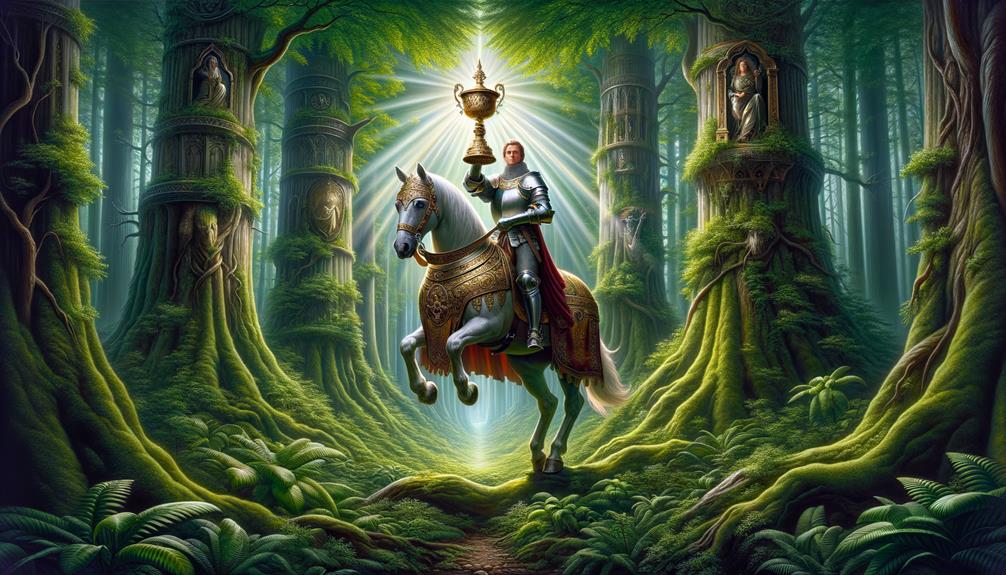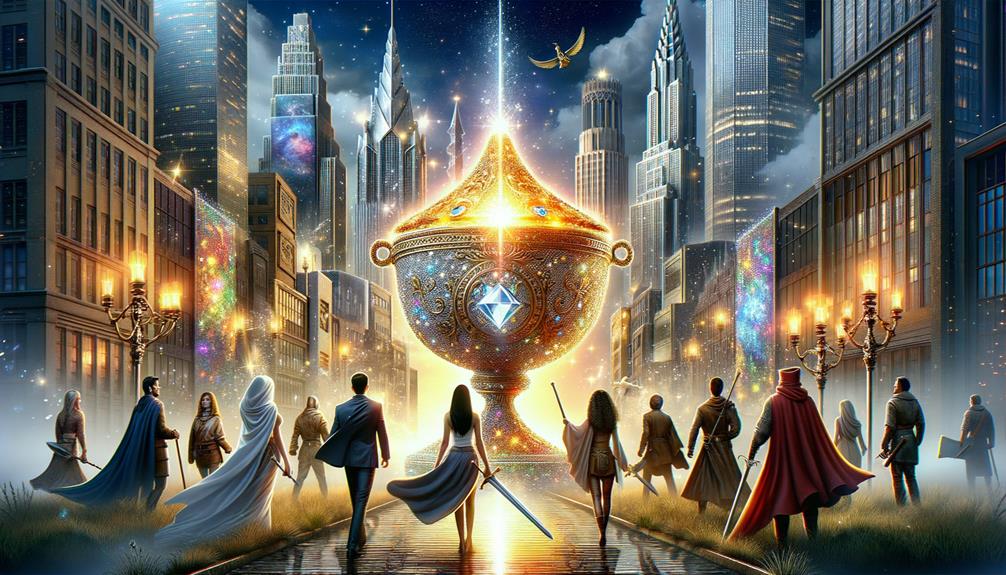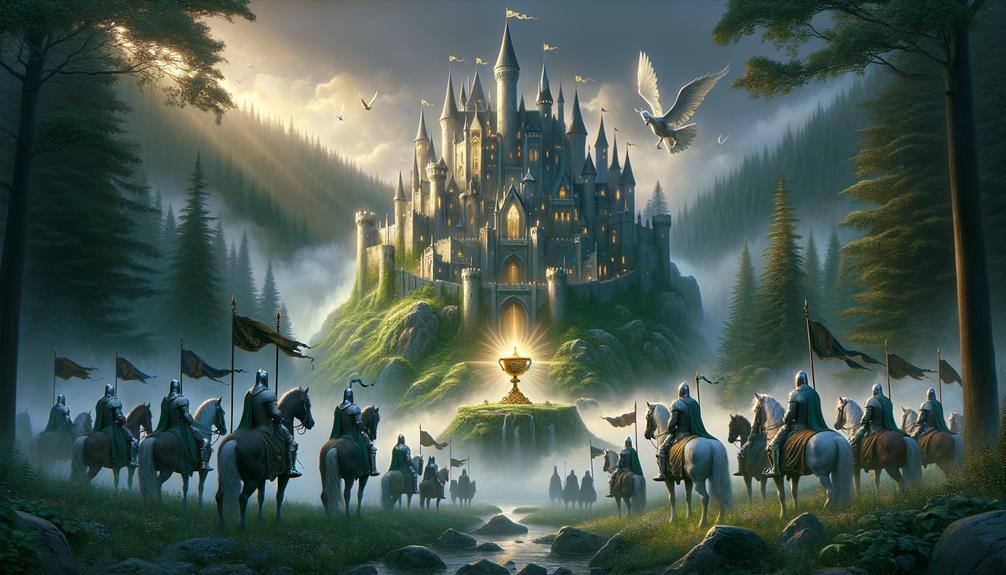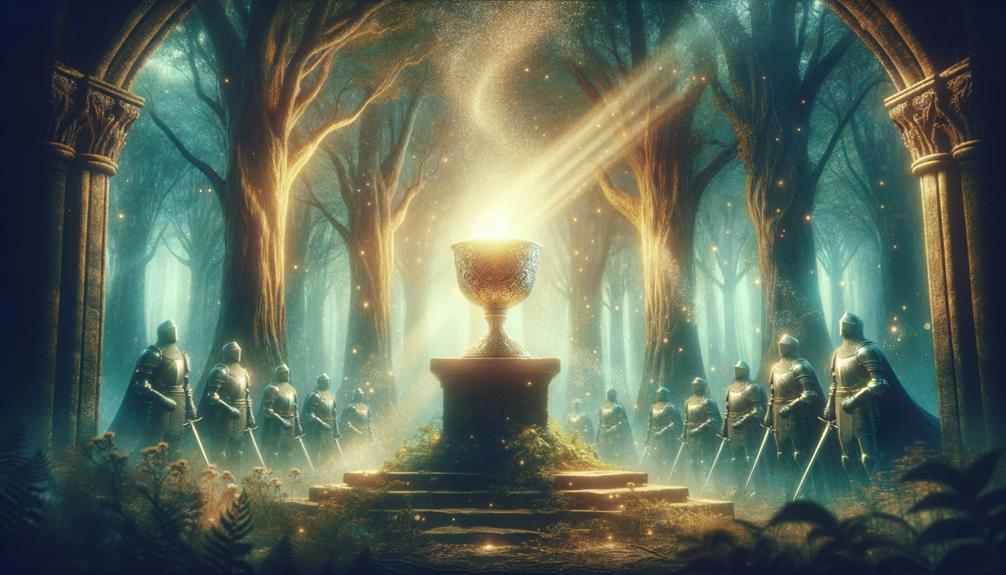The quest for the Holy Grail in Arthurian legend, a profound journey towards spiritual awakening and redemption, still captivates us today. Sir Galahad’s pursuit mirrors our yearning for truth – an odyssey symbolizing inner transformation and unwavering faith. This timeless tale transcends knights and relics, speaking to humanity’s deeper desires for enlightenment and purpose.
The Grail’s elusive quality reflects our ongoing search for meaning, compelling us to examine the legend’s enduring resonance. Its mystique persists, inviting exploration of eternal virtues like purity of heart and steadfast belief. This ancient narrative remains relevant by tapping into universal human experiences and aspirations.
Origin and Etymology
The phrase “Holy Grail” has a rich, layered history rooted in ancient myths and legends. Initially, it referred to a simple dish or container, but authors like Chrétien de Troyes imbued it with spiritual symbolism in the late 1100s. His work Perceval introduced the Holy Grail as a sacred object sought by King Arthur’s knights.
Over time, other writers expanded on this concept. Robert de Boron cast it as a symbol of divine grace, while Wolfram von Eschenbach‘s epic Parzival explored the grail as representing inner enlightenment. The grail’s mystique evolved from cultural influences, capturing humanity’s timeless yearning for greater meaning.
This legendary vessel’s origins seamlessly wove diverse storytelling threads. From mundane beginnings emerged a powerful metaphor resonating across generations. The Holy Grail’s transformative journey mirrors our ongoing quest to find significance in the world around us.
Medieval Literature

The Holy Grail‘s symbolism gained immense significance in medieval literature, intertwining with King Arthur‘s epic saga. The tale invited readers to embark on an inner journey, a quest for divine enlightenment. The pure-hearted knight, often Sir Galahad, emerged as the destined hero capable of achieving what others could not.
The Vulgate Cycle, a cornerstone of Arthurian literature, meticulously detailed this pursuit of the Holy Grail, emphasizing its sacredness and the trials faced by those seeking it. The castle of Corbenic stood as a mystical locale where the Grail King guarded the sacred vessel. This wounded or suffering king symbolized a land in need of spiritual restoration.
The Siege Perilous, an empty seat at the Round Table, awaited the Grail hero—only the most virtuous could occupy it unharmed. This seat underscored the purity required to approach the Grail. Works like Le Conte du Graal and Welsh literature enriched the narrative, blending Christian mysticism with Celtic myth.
Each tale added layers to the quest, portraying it as not just a physical journey but a path to inner enlightenment and divine grace. Consequently, the legend of the Holy Grail became an enduring symbol of spiritual aspiration in medieval literature.
Later Traditions

The Grail legends continued evolving well beyond the Middle Ages. As time passed, the Holy Grail transformed from a simple cup to a profound Christian symbol resonating deeply with King Arthur’s knights. This shift was evident in the Vulgate Cycle, where the Grail quest adopted greater spiritual meaning.
Enter Sir Galahad, a pure-hearted knight whose fate intertwined with the Grail itself. His journey, filled with divine interventions and trials, exemplified the ultimate Grail quest. It wasn’t merely about locating a sacred object, but a pilgrimage toward enlightenment.
Key aspects included Galahad’s visionary revelation of the Grail, the chalice’s role as a vessel of divine grace, other knights like Bors and Perceval joining the search, and personal sacrifices leading to the Grail’s ascension to Heaven. Camelot became a stage exploring the eternal conflict between earthly desires and heavenly aspirations.
Modern Interpretations

The Holy Grail legend continues captivating our imagination, appearing in modern novels, movies, and video games as a symbolic quest for truth. T.S. Eliot’s poem “The Waste Land” and Umberto Eco’s book “Foucault’s Pendulum” investigate desolation and the search for meaning, paralleling the Grail quest itself.
Films like “The Da Vinci Code” portray the Grail as a hidden truth, while “Monty Python and the Holy Grail” humorously parodies the ancient legend. Video games such as “Assassin’s Creed” and “Dark Souls” depict the Grail driving the hero’s perilous journey, rife with symbolic meaning. TV shows like “Merlin” and “Supernatural” explore the Grail’s mystical properties.
Even musicians like Led Zeppelin tap into the Grail’s epic motifs, evoking spiritual longing through song, ensuring the legend endures in contemporary culture.
Cultural Impact

The Holy Grail’s legacy echoes across time, from T.S. Eliot’s desolate poetry to Monty Python’s satirical lens. As a timeless symbol of humanity’s spiritual quest, the Grail intertwines with Arthurian legend, spawning countless retellings in literature, opera, and film – each capturing its mystique and profound symbolism.
In literature, the Grail represents the quintessential journey seeking enlightenment and divine truth. Operas like Wagner’s ‘Parsifal’ transform this odyssey into a dramatic, sacred experience. Films like ‘Indiana Jones and the Last Crusade’ blend adventure with the Grail’s legendary allure, testament to its enduring impact.
- Literary gems: T.S. Eliot’s ‘The Waste Land’
- Operatic tales: Wagner’s ‘Parsifal’
- Cinematic classics: ‘Monty Python and the Holy Grail,’ ‘Indiana Jones and the Last Crusade’
- Contemporary adaptations: TV shows, music
The Grail’s influence transcends traditional art forms, permeating pop culture with modern takes that fascinate audiences anew. Through myriad adaptations, this ancient relic remains a potent symbol of our eternal yearning for meaning.
Frequently Asked Questions
Did Lancelot Find the Holy Grail?
My pursuit of the Holy Grail, that revered symbol of divine grace, never bore fruit. My heart’s entanglement with Guinevere overshadowed the quest, leaving the sacred achievement to the purer souls like Galahad.
Which of Arthur’s Knights Found the Holy Grail?
I embarked on a sacred mission, guided by divine visions, to locate the ultimate symbol of purity—the Holy Grail. As Sir Galahad, my quest led me to this sacred relic. With my purpose fulfilled, I transcended this world, embodying the eternal pursuit of enlightenment.
Who Are the Three Achievers of the Holy Grail in Arthurian Legend?
In Arthurian folklore, the knights Sir Bors, Sir Perceval, and Sir Galahad attained the Holy Grail after a perilous journey marked by tests of faith and resolve. Their quest epitomized heroic determination against all odds.
Was the Holy Grail in Camelot?
The vision of the Holy Grail guided Camelot’s knights on an extraordinary quest beyond their realm, pursuing higher truth. Destiny compelled us to leave that kingdom, embodying humanity’s eternal pursuit of enlightenment through our journey into the unknown. That vision symbolized our noble calling rather than a physical object within Camelot’s walls.


